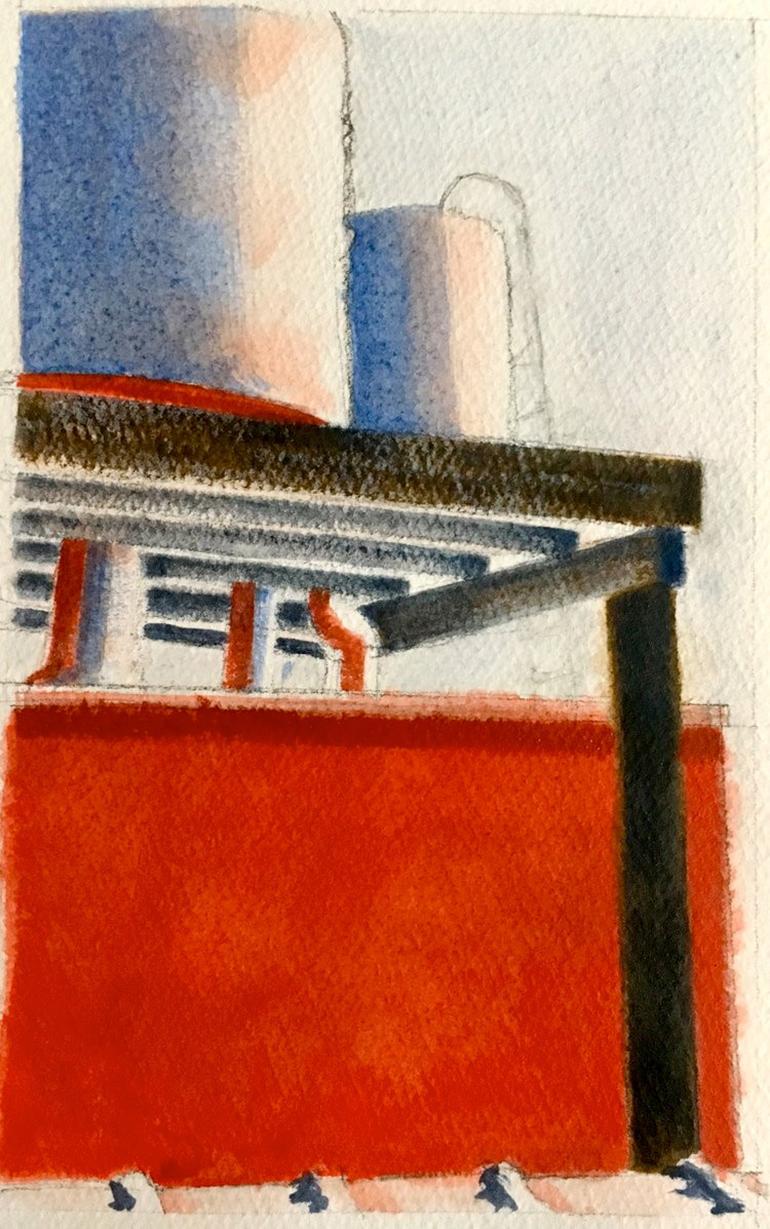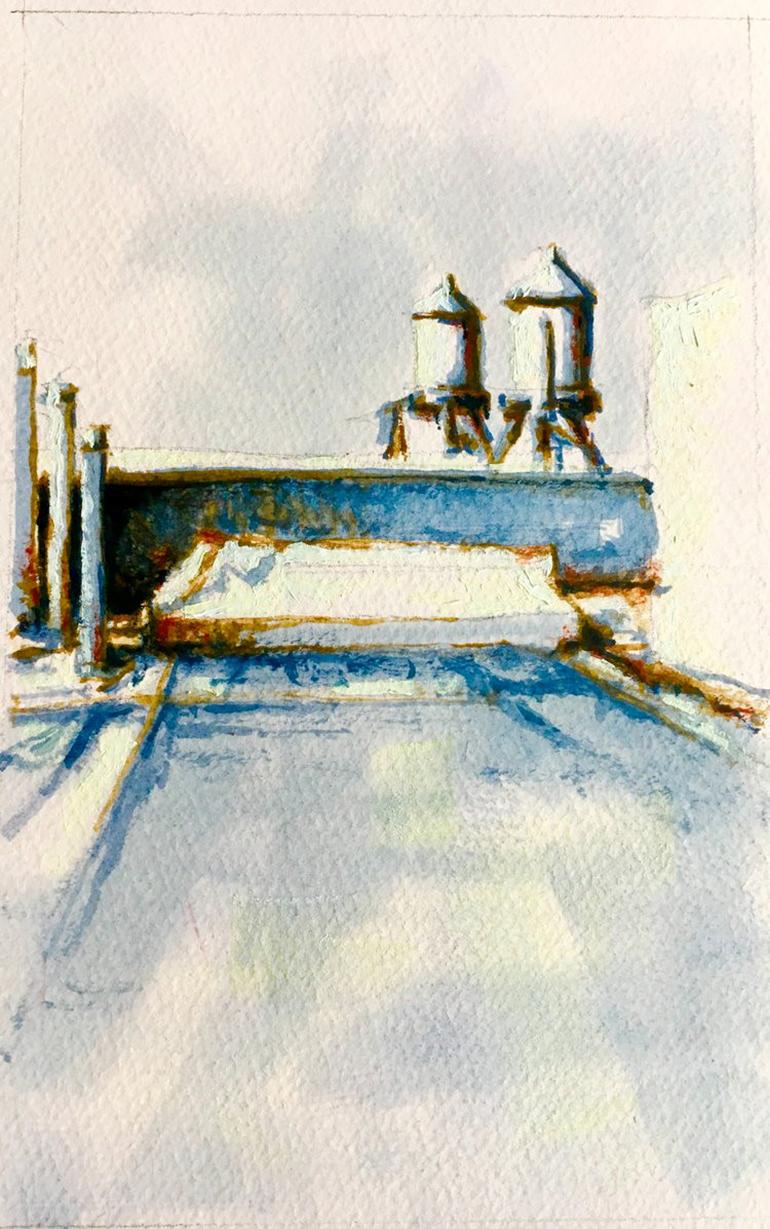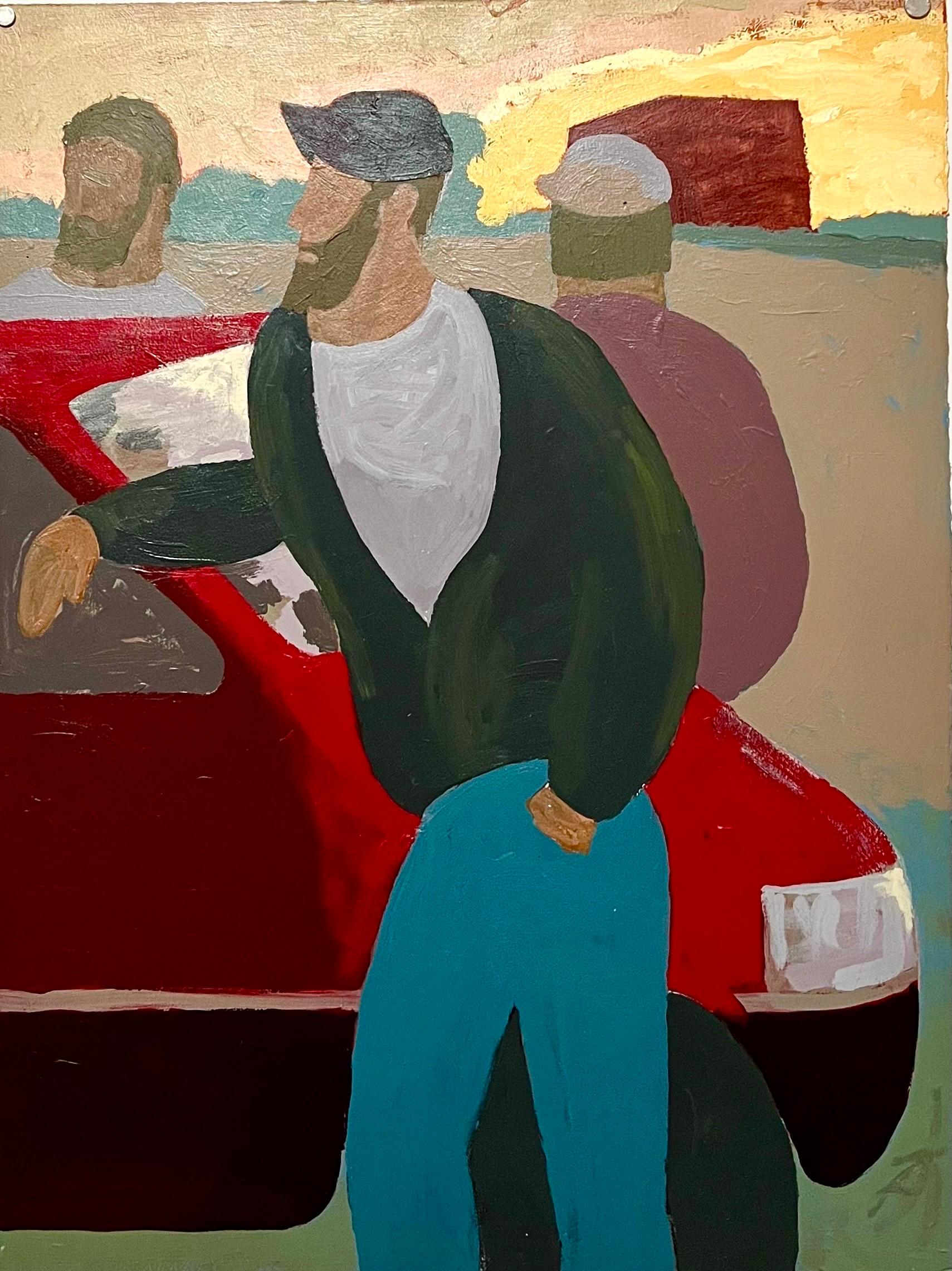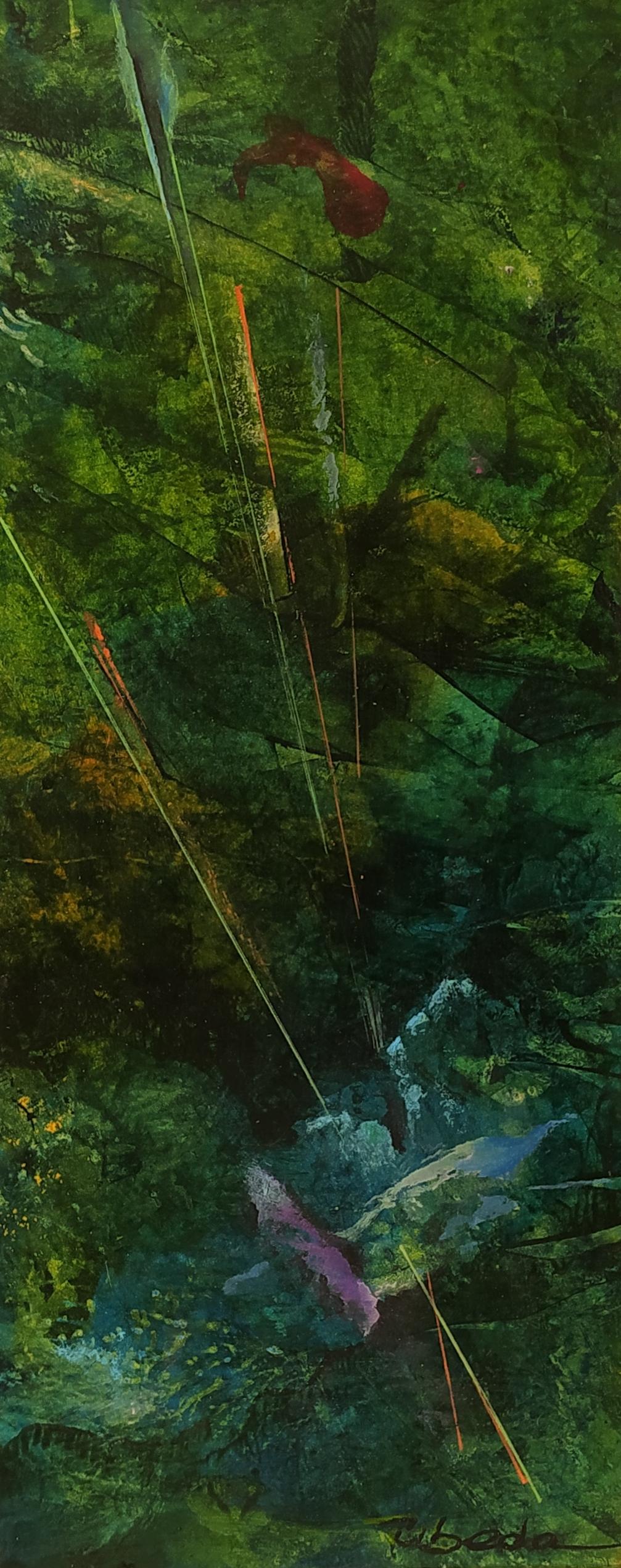Items Similar to "Hiddensee, Herbst (Autumn)" Hans Hofmann, Modern German Abstract Landscape
Want more images or videos?
Request additional images or videos from the seller
1 of 12
Hans Hofmann"Hiddensee, Herbst (Autumn)" Hans Hofmann, Modern German Abstract Landscape1927
1927
About the Item
Hans Hofmann
Hiddensee, Herbst (Autumn), 1927
Signed with initials and dated lower left; titled on the reverse
Oil on paper
18 x 22 inches
Provenance:
John Adams Fine Art, London
Private Collection, New York
Private Collection, Scarsdale
The only artist of the New York school to participate directly in European modernism, Hans Hofmann became known as the major exponent of Abstract Expressionism. His paintings are known for their manic, exuberant energy. Among 20th-century masters, he was the first to consolidate and codify the lessons of modernism into a teaching system. Hofmann was also a widely-influential art instructor with schools in New York City and Provincetown, Massachusetts. He was described by "New York Times" critic Clement Greenberg as "the most important teacher of our time." Approximately six-thousand students studied modernist art with him, among the well-known names are Helen Frankenthaler, Jane Freilicher, Wolf Kahn, Larry Rivers and Nell Blaine.
Hans Hofmann was born in Weissenberg, Germany, showed a precocious interest in music and science, and had early training in mechanics while working for the Director of Public Works of Bavaria between 1896 and 1898. On that job, he invented the electromagnetic comptometer, the precursor of the adding machine.
He began to study art in 1898 in Munich where he was introduced to Impressionism. From 1904 to 1914, he studied in Paris and was exposed to many of the avant-garde artists and movements of that time including Fauvism, Cubism, and Surrealism. He was much taken with the exploration of pure color for its own sake, especially as investigated by Picasso, Braque, Matisse, and Delaunay.
In Munich at the outbreak of World War I, he founded an art school and was highly successful until 1932 when he emigrated to America, having spent the summers in 1930 and 1931 teaching at the University of California at Berkeley.
In 1932, he began teaching at the Arts Students League in New York and the following year opened his own schools in New York and Provincetown, Massachusetts. During the 1930s and 1940s, American Scene painting was prevalent, but he resisted that style, staying with the modernism to which he had been exposed in Europe. Hence he was later credited as a courageous pioneer in America of European modern art.
He closed both of his schools in 1958 so he could devote himself full time to his own painting. He died in New York City in 1966.
Hofmann said he always based his paintings on the subject of nature, and he used vivid colors such as bright blues, greens oranges and yellows and applied them with palette knives in long slashing strokes. He viewed the surface of the canvas as alive, responsive, and active, often with opposing forces which he created with his theory of "push and pull," and which is closely tied to theories of Paul Cezanne. He also experimented with dripping paint onto the canvas, a method Jackson Pollock learned and later made famous.
Most of the configurations of his later paintings were rectangular, likely influenced by the analytical Cubism of Picasso, and which he fled were best in accord with the overall shape of the canvas.
- Creator:Hans Hofmann (1880-1966, German)
- Creation Year:1927
- Dimensions:Height: 24 in (60.96 cm)Width: 28 in (71.12 cm)
- Medium:
- Movement & Style:
- Period:
- Condition:
- Gallery Location:New York, NY
- Reference Number:1stDibs: LU1841212376322
About the Seller
5.0
Platinum Seller
These expertly vetted sellers are 1stDibs' most experienced sellers and are rated highest by our customers.
Established in 2021
1stDibs seller since 2022
59 sales on 1stDibs
Typical response time: 1 hour
- ShippingRetrieving quote...Ships From: New York, NY
- Return PolicyA return for this item may be initiated within 3 days of delivery.
More From This SellerView All
- "Colorado Landscape, " Western Precisionist Regionalism American Scene PaintingBy William SandersonLocated in New York, NYReminiscent of an Edward Hopper or Andrew Wyeth scene, or even Charles Demuth with its cubist elements. William Sanderson (1905 - 1990) Colorado Landscape Oil on canvas 23 1/2 x 31 1/2 inches Signed lower right: Sanderson Born in Dubbeln, near Riga, Latvia in 1905, his personal journey from Czarist Russia, to New York City, and finally to Colorado, is one of remarkable courage and perseverance. Sanderson exhibited in numerous solo and group exhibitions throughout Colorado and the West between 1945 and 1985, and he was voted one of Colorado's influential artists of the 20th Century. Sanderson's paintings are represented in many museums and are sought after by collectors who appreciate his composition and precise use of color. The year 2005 marked the Centennial of Sanderson's birth, and he is now recognized as a major contributor to the development of modern art in Colorado. As a student at the National Academy of Design in 1927, Sanderson exemplifies an individual dedicated to creativity and the life-long passion for art. Known primarily as a Colorado artist, Sanderson first developed his skills as a graphic illustrator in New York City, and his work has appeared in numerous magazines, including New Yorker and New Masses. Notable book illustrations include The Jumping Off Place - 1929, by Marion Hurd McNeely, Jews Without Money - 1930, by Michael Gold...Category
Mid-20th Century American Modern Landscape Paintings
MaterialsCanvas, Oil
- "Harvard vs Yale" Charles Green Shaw, Football, Ivy League Sports, AbstractBy Charles Green ShawLocated in New York, NYCharles Green Shaw Harvard vs. Yale, 1944 Signed and dated on the reverse Oil on canvasboard 9 x 12 inches Provenance: Harvey and Francois Rambach, New Jersey Private Collection, California Washburn Gallery, New York D. Wigmore Fine Art, New York Private Collection, New York Charles Green Shaw, born into a wealthy New York family, began painting when he was in his mid-thirties. A 1914 graduate of Yale, Shaw also completed a year of architectural studies at Columbia University. During the 1920s Shaw enjoyed a successful career as a freelance writer for The New Yorker, Smart Set and Vanity Fair, chronicling the life of the theater and café society. In addition to penning insightful articles, Shaw was a poet, novelist and journalist. In 1927 he began to take a serious interest in art and attended Thomas Hart Benton's class at the Art Students League briefly in New York. He also studied privately with George Luks, who became a good friend. Once he had dedicated himself to non-traditional painting, Shaw's writing ability made him a potent defender of abstract art. After initial study with Benton and Luks, Shaw continued his artistic education in Paris by visiting numerous museums and galleries. From 1930 to 1932 Shaw's paintings evolved from a style imitative of Cubism to one directly inspired by it, though simplified and more purely geometric. Returning to the United States in 1933, Shaw began a series of abstracted cityscapes of skyscrapers he called Manhattan Motifs which evolved into his most famous works, the shaped canvases he called Plastic Polygons. The 1930s were productive years for Shaw. He showed his paintings in numerous group exhibitions, both in New York and abroad, and was also given several one-man exhibitions. Shaw had his first one-man exhibition at the Valentine Dudensing Gallery in New York in 1934, which included 25 Manhattan Motif paintings and 8 abstract works. In the spring of 1935 Shaw was introduced to Albert Gallatin and George L.K. Morris. Gallatin was so impressed with Shaw's work, he broke a policy against solo exhibitions at his museum, the Gallery of Living Art, and offered Shaw an exhibition there. In the summer of 1935 Shaw traveled to Paris with Gallatin and Morris who provided introductions to many great painters. Shaw regularly spent time with John Ferren and Jean Hélion. The following year Gallatin organized an exhibition called Five Contemporary American Concretionists at the Reinhardt Gallery that included Shaw, Ferren, and Morris, Alexander Calder, and Charles Biederman...Category
1940s Abstract Geometric Landscape Paintings
MaterialsOil, Board
- "Colonial Sand and Stone Company, New York, " Industrial WPA Scene, PrecisionistBy William SharpLocated in New York, NYWilliam Sharp (1900 - 1961) Factory on the River Oil on canvas 20 1/2 x 28 1/2 inches Initialed lower left: WS Provenance: Estate of the artist Private Collection, New York Swann Auction Galleries, American Art, June 13, 2019, Lot 178 Private Collection, New York Colonial Sand and Stone Co., founded by Generoso Pope, was once the country’s largest sand and gravel business, providing the concrete for much of New York City’s skyline, including the Empire State Building, Rockefeller Center, Radio City Music Hall, airports and subways. William Sharp was born on June 13, 1900, in Lemberg, Austria, where he attended college and the Academy for Arts and Industry. He later studied in Kraków, Poland, and in Berlin and Munich, Germany. Sharp began his career as a designer of stained-glass windows and as a painter of murals. He served in the German army during World War I. After the war he became a newspaper artist in Berlin and a well-known etcher. Sharp drew political cartoons that were bitterly critical of the growing Nazi movement. As the influence of National Socialism intensified, he began to contribute drawings, under a pseudonym, to publications that were hostile to Hitler. After Hitler assumed power, Sharp was confronted with these drawings and told that he would be sent to a concentration camp. However, in 1934, he escaped to the United States. His first newspaper assignment in America was making courtroom sketches for The New York Mirror...Category
Mid-20th Century American Realist Landscape Paintings
MaterialsCanvas, Paint, Oil
- "Factory on the River, " Modernist and Precisionist WPA Industrial New York SceneBy William SharpLocated in New York, NYWilliam Sharp (1900 - 1961) Factory on the River Oil on canvas 17 1/2 x 23 1/4 inches Initialed lower right: WS Provenance: Estate of the artist Private Collection, New York Swann Auction Galleries, American Art, June 13, 2019, Lot 178 William Sharp was born on June 13, 1900, in Lemberg, Austria, where he attended college and the Academy for Arts and Industry. He later studied in Kraków, Poland, and in Berlin and Munich, Germany. Sharp began his career as a designer of stained-glass windows and as a painter of murals. He served in the German army during World War I. After the war he became a newspaper artist in Berlin and a well-known etcher. Sharp drew political cartoons that were bitterly critical of the growing Nazi movement. As the influence of National Socialism intensified, he began to contribute drawings, under a pseudonym, to publications that were hostile to Hitler. After Hitler assumed power, Sharp was confronted with these drawings and told that he would be sent to a concentration camp. However, in 1934, he escaped to the United States. His first newspaper assignment in America was making courtroom sketches for The New York Mirror...Category
Mid-20th Century American Realist Landscape Paintings
MaterialsCanvas, Paint, Oil
- "Tabac" Charles Green Shaw, Tobacco, Smoking, Park Ave Cubist, AAABy Charles Green ShawLocated in New York, NYCharles Green Shaw Tabac, circa 1935 Signed on the reverse Oil on canvasboard 5 3/4 x 8 3/4 inches Provenance: Washburn Gallery, New York, 1982 Private Collection (acquired from the above) Christie's, The Collector, October 20, 2021, Lot 307 Private Collection, Scarsdale, New York (acquired directly from the above) Literature: Hilton Kramer, "Charles Shaw: In the Minimal Tradition," New York Times, February 21, 1982, Section 2, p. 25. Charles Green Shaw was born in 1892 to a wealthy New York family. He lost both his parents at a very young age; his mother died when he was just three years old. Despite the early loss of his parents, Shaw lived the whimsical life of a New York socialite. As a beneficiary to an inheritance based in part upon the Woolworth fortune, he was brought up surrounded by the well-bred, well-groomed and well-moneyed citizens of New York’s elite social class. His social status as an adolescent was cultivated while spending summers in Newport and attending Christmas balls at Mrs. W.K. Vanderbilt’s. At age six, Shaw began to take an interest in drawing, and by nine, he was known to have a fondness for sketching historical costumes. After graduating from Yale University in 1914, Shaw spent a year studying at Columbia University’s School of Architecture. Subsequently he served for eighteen months as a Lieutenant in World War I. After his service, Shaw returned to New York and tried his hand as a businessman selling real estate, but his attempt was short lived. In the early 1920s, Shaw began his career as a journalist and novelist. He achieved professional success, writing consistently for magazines such as The New Yorker, Vanity Fair and The Smart Set. Shaw’s writing was a record of his approvals and disapprovals of the social crowd to which he belonged. His profession along with his social pedigree, brought him in contact with a number of the most significant figures of the 1920s such as, F. Scott Fitzgerald, Sinclair Lewis, George Gershwin, George Jean Nathan and the American artist George Luks. Some of his profiles included celebrity caricatures used as illustrations, these were the publics’ first look at Shaw’s artistic ability. In 1928, a collection of Shaw’s articles and interviews were published in one volume titled, The Low Down. Just previous to the stock market crash and the end of the Jazz Age, Shaw left New York and traveled to Paris and London. He arrived in Paris in 1929. In an autobiographical note Shaw suggests it was on this trip when he first began to paint seriously. London also acted as a great source of motivation for the budding artist. He began to sketch everyday in St. James’s Park, making large pastels of its vistas in the style of Cezanne. When he returned to New York in 1932, Shaw considered himself a painter. Success for Shaw came quickly with his first solo exhibition mounted at the Valentine Gallery in 1934. The following year Albert Eugene Gallatin included works by the artist in an unprecedented solo exhibition at his Gallery of Living Art at New York University. Shaw further cemented his reputation as an artist through his association and friendship with fellow abstract artists Morris and Gallatin. The trio soon was regarded as ‘the Park Avenue Cubists’. As a founding member of the American Abstract Artists, Shaw became an impassioned defender of the style. His 1938 essay in the American Abstract Artists yearbook, “A Word to the Objector”, acted as a defense against those who failed to see the illustrative quality of abstract art and scolded those who disregarded American artists as serious Abstractionists. He was also an influential force at the Museum of Modern Art, where he sat on the Advisory Board from 1936 to 1941. In the later years of Shaw’s life he continued to produce abstract paintings, yet in a more private manner. He was known to be a reserved man— a ‘gentleman’; not much is known about his personal life in these later years. During this time he maintained his career as a writer, publishing the well-known children’s book, It Looked Like Spilt Milk in 1940 and two books of poems in 1959 and 1962. In 1974, Shaw died...Category
1930s Cubist Landscape Paintings
MaterialsOil, Board
- "Midsummer Night" Gerome Kamrowski, Color Field, Abstract ExpressionismBy Gerome KamrowskiLocated in New York, NYGerome Kamrowski Midsummer Night, 1973 Signed upper left Acrylic on canvas 16 x 20 inches Gerome Kamrowski was born in Warren, Minnesota, on January 19, 1914. In 1932 he enrolled in...Category
1970s Abstract Expressionist Abstract Paintings
MaterialsFoam, Mixed Media, Acrylic, Board
You May Also Like
- Untitled I (Abstracted Cityscape Painting of Skyline & Water Towers in Blue)By Ricardo MuleroLocated in Hudson, NYAbstracted cityscape painting on paper in blue, black, grey and white oil wash of an industrial New York City rooftop "Untitled I," painted by Ricardo Mulero in 2018 7.5 x 5 inches, oil wash on paper 16.5 x 13.5 inches in a soft white wood frame with an 8-ply window mat and non-glare glass Excellent condition, ready to hang as is Ricardo Mulero is fascinated with capturing the brilliance of light and the contrast of natural beauty with utilitarian landscapes. Here, Mulero focuses on an abstracted New York City rooftop where water towers stand in the distance. Contrasts in light and shadow accentuate the urban landscape's geometric forms and highlight bold color palettes of blue, black, and grey. The piece is in excellent condition and ready to hang. About the Artist: Growing up in Puerto Rico, I observed how people and nature could co-exist in harmony. Today, that principle guides my design and artistic work. My paintings are expressions that draw upon my life experiences, traditions, and surroundings. These unique environments inspire my oil paintings: Puerto Rico, where I grew up, New York City, Fire Island Pines...Category
2010s Modern Landscape Paintings
MaterialsArchival Paper, Oil
- Untitled II (Abstract Cityscape Painting of Skyline & Water Tower in Red & Blue)By Ricardo MuleroLocated in Hudson, NYAbstracted cityscape painting on paper in blue and red oil wash of industrial beams and water towers in New York City "Untitled II," painted by Ricardo Mulero in 2018 7.5 x 5 inches, oil wash on paper 16.5 x 13.5 inches in a soft white wood frame with an 8-ply window mat and non-glare glass Excellent condition, ready to hang as is Ricardo Mulero is fascinated with capturing the brilliance of light and the contrast of natural beauty with utilitarian landscapes. Here, Mulero focuses on an abstracted New York cityscape of rooftop water towers and he fragments the industrial urban landscape to highlight bold shapes with contrasting color palettes in blue, black, and red. The piece is in excellent condition and ready to hang. About the Artist: Growing up in Puerto Rico, I observed how people and nature could co-exist in harmony. Today, that principle guides my design and artistic work. My paintings are expressions that draw upon my life experiences, traditions, and surroundings. These unique environments inspire my oil paintings: Puerto Rico, where I grew up, New York City, Fire Island Pines...Category
2010s Modern Landscape Paintings
MaterialsOil, Archival Paper
- Large Hudson River Figurative Modernist Landscape Oil Painting Edward AvedisianBy Edward AvedisianLocated in Surfside, FLEdward Avedisian ( 1936-2007 ) Gouache or oil on paper, 3 guys around a car, hand signed in paint lower left, Measures 30"x 22.5" Edward Avedisian (June 15, 1936, Lowell, Massachusetts – August 17, 2007, Philmont, New York) was an American abstract painter who came into prominence during the 1960s. His work was initially associated with Color field painting and in the late 1960s with Lyrical Abstraction and Abstract Expressionism. He studied art at the School of the Museum of Fine Arts, Boston. By the late 1950s he moved to New York City. Between 1958 and 1963 Avedisian had six solo shows in New York. In 1958 he initially showed at the Hansa Gallery, then he had three shows at the Tibor de Nagy Gallery and in 1962 and 1963 at the Robert Elkon Gallery. He continued to show at the Robert Elkon Gallery almost every year until 1975. During the 1960s his work was broadly visible in the contemporary art world. He joined the dynamic art scene in Greenwich Village, frequenting the Cedar Tavern on Tenth Street, associating with the critic Clement Greenberg, and joining a new generation of abstract artists, such as Darby Bannard, Kenneth Noland, Jules Olitski, and Larry Poons. Avedisian was among the leading figures to emerge in the New York art world during the 1960s. An artist who mixed the hot colors of Pop Art with the cool, more analytical qualities of Color Field painting, he was instrumental in the exploration of new abstract methods to examine the primacy of optical experience. One of his paintings was appeared on the cover of Artforum, in 1969, his work was included in the 1965 Op Art The Responsive Eye exhibition at the Museum of Modern Art and in four annuals at the Whitney Museum of American Art. His paintings were widely sought after by collectors and acquired by major museums in New York and elsewhere. He has been exhibited in prominent galleries, such as the Anita Shapolsky Gallery and the Berry Campbell Gallery in New York City. Edward Avedisian was known for his brightly colored, boldly composed canvases that combined Minimalism's rigor, Pop art exuberance and the saturated tones of Color Field painting. Roberta Smith of the NYT writes of Avedesian: "Edward Avedisian helped establish the hotly colored, but emotionally cool, abstract painting that succeeded Abstract Expressionism in the early 1960s. This young luminary harnessed elements of minimalism, pop, and color field painting to create prominent works of epic proportions that energized the New York art scene of the time." In 1996 Avedisian showed his paintings from the 1960s at the Mitchell Algus Gallery, then in SoHo. His last show, dominated by recent landscapes, was in 2003 at the Algus gallery, now in Chelsea. Selected Exhibitions: Op Art: The Responsive Eye, at the Museum of Modern Art, Whitney Museum’s Young America 1965 Expo 67, held in Montreal, Canada. Six Painters (along with Darby Bannard, Dan Christensen, Ron Davis...Category
20th Century American Modern Landscape Paintings
MaterialsOil, Gouache, Archival Paper
- Large 1960 California "Abstract Landscape" Jack Stuck PaintingLocated in Arp, TXJack Stuck (1925-1993) "Abstract Landscape" 1960 Collage oil paint, charcoal, paper and canvas laid down on masonite 48"x46" natural wood frame 51" x 49" Si...Category
Mid-20th Century American Modern Abstract Paintings
MaterialsCanvas, Masonite, Charcoal, Oil, Laid Paper
- Under The Sea Series Nº 25. Úbeda. Oil fantasy underwater green landscapeLocated in Segovia, ESUnder The Sea Series Nº 25. Oil on paper. Fantasy underwater abstract landscape. Green color. Transparencies effect. Measurements: (H) 39 cm. / 1...Category
2010s Modern Abstract Paintings
MaterialsPaper, Oil
- Under The Sea Series Nº 23. Úbeda. Oil fantasy underwater blue-green landscapeLocated in Segovia, ESUnder The Sea Series Nº 23. Oil on paper. Fantasy underwater abstract landscape. Green-blue color. Transparencies effect. Measurements: (H) 35 cm....Category
2010s Modern Abstract Paintings
MaterialsPaper, Oil
Recently Viewed
View AllMore Ways To Browse
Fishermen Painting
David T Kim
Large 19th Century Forest Oil Painting
East Coast Florida Landscape
B Harvey Oil Painting
Beach Dune Painting
Eugene Felix
Alex Perez On Sale
Alexander Titorenkov
Alfons Walde
Alhambra 3 Ramon Enrich
Alphonse Maureau
Antoine Blanchard On Sale
Beverly Myers
Blanche Hoschede Monet
Blanche Hoschede
Blood Coral Buddha
Clive Pates




